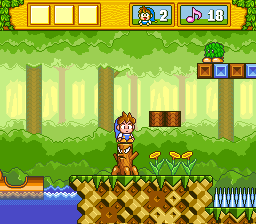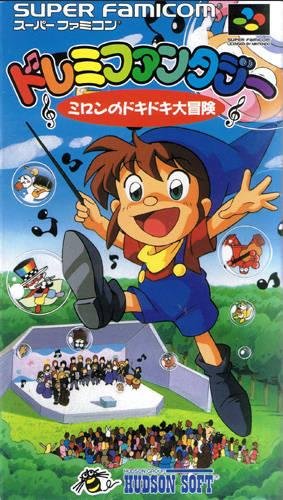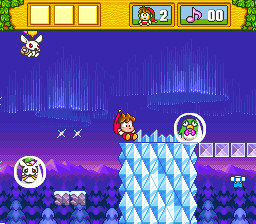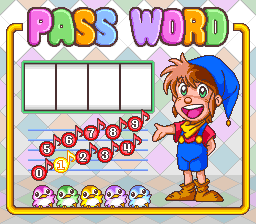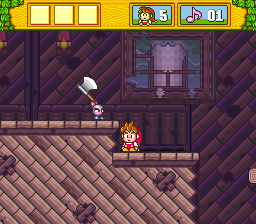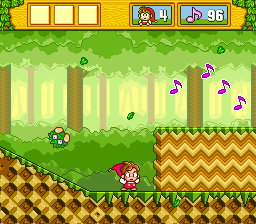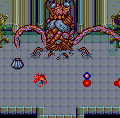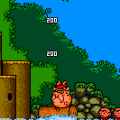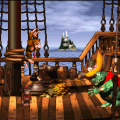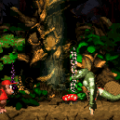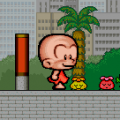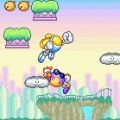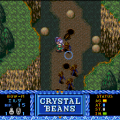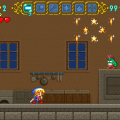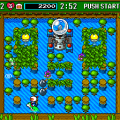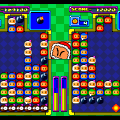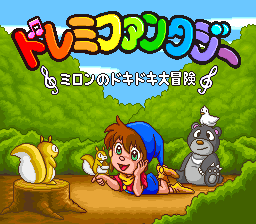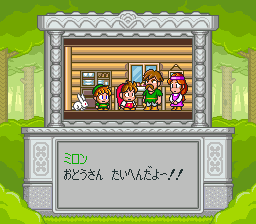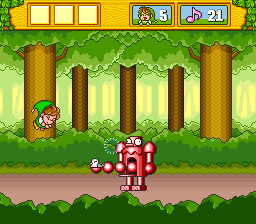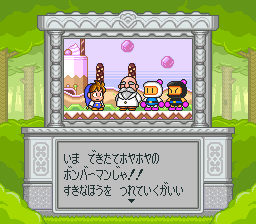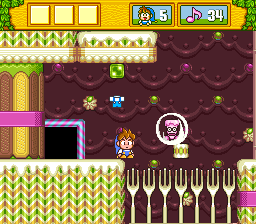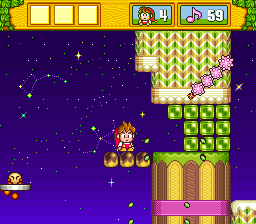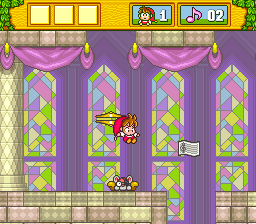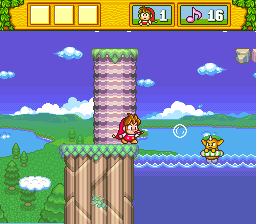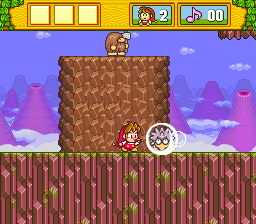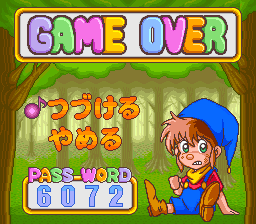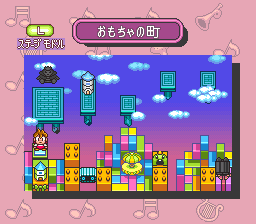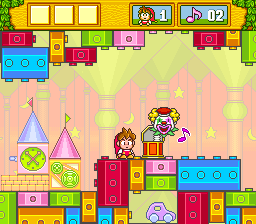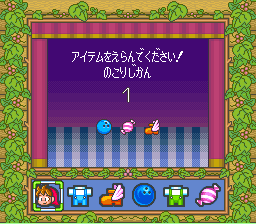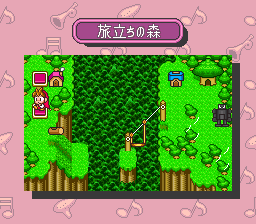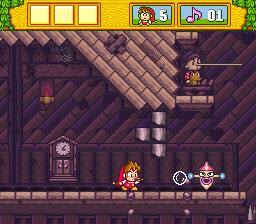- Milon’s Secret Castle
- DoReMi Fantasy: Milon no Doki Doki Daibouken
- Milon no Hoshizora Shabon: Puzzle Kumikyoku
After Milon’s initial outing in 1986, the character sulked back into the shadows as Hudson prioritized the adventures (and revenges) of Master Takahashi/Higgins and Bonk, their other platformer mascots. But a whole decade later, in the waning years of the Super Famicom, they brought him out for another go with DoReMi Fantasy: Milon no Doki Doki Daibouken (“Milon’s Exciting Adventure”). At this point, obtuse puzzle-adventures like Milon’s Secret Castle were deeply out of fashion, and so instead Hudson decided to make a more straightforward Super Mario World-style platformer. Taking place across seven worlds, complete with a level map screen, Milon must rescue the fairy princess Alis while defeating the wizard Amon, whose subordinates have stolen the magical instruments of his kingdom of Fantasia.
Milon still keeps his bubble-blowing flute, which now encases enemies in a bubble and can be launched upwards to trap other foes. It also now shoots in forward shots, rather than angled upwards or downwards, one of the major tweaks that makes DoReMi Fantasy infinitely easier to play than its predecessor. You can also hold down the attack button to charge an attack that sends out several bubbles in different directions. In traditional platformer fashion, you can also jump on enemies, though this only stuns them for a few seconds. Bubbles can still be used to break certain blocks, and while there are plenty of hidden areas that are carved out by blowing at them, it’s not nearly as central to the game as its predecessor, and it’s usually clear which blocks are secretly destructible even if they look identical to regular scenery.
Rather than having a life bar, Milon’s hit points are determined by the color of his elf-like outfit. At green, he’s at full strength, but get hit and he turns blue, and then red, which means that one more hit will cause a lost life. Found throughout the stages are various items, like winged boots, which let you float down from jumps; spiked shoes to reduce slippage on ice; and bubble gum, which will save you from falling down a pit. Some stages also have bonus levels, where you need to shoot down birds, count how many of them zoom past, or identify which types of items are flung from the side of the screen.
In exploring the fairly large levels, you can grab musical notes – 100 grants an extra life, as expected – or hunt for these extra items. However, in general the difficulty is pretty low, so you may not need to put in the extra legwork. However, from the second world onwards, certain levels will have a hidden star somewhere, which needs to be found if you want to move onto the next world. This is, again, nowhere near as complicated as any of the baffling puzzles back in the NES game. Collected instruments also give you extra skills, which are typically used in the following world. The accordion lets you swim underwater, the trumpet lets you create platforms wherever you see twinkling stars, and the ocarina lets you create ladders using musical notes. Technically you can go back to previously completed stages and use these abilities to find new areas, but there’s never much of a reason to. Progress is also saved after every world via a simple password system.
The game’s charms lie in the details. Milon is an absolutely adorable little hero, with all of his animation frames filled with character. Watch the way he charges forward with purpose, the way he flips when he jumps, and how his expression changes and his pants billow as he falls from a high jump. When he falls into a pit, he even holds his nose like he’s diving into water. These types of touches can be found with the enemies and the environment as well. Windy areas have been in platformers since at least Super Mario Bros. 2 (the Japanese one), but here, it affects how Milon looks, as he tries to push against the gusts while it sends hapless enemies flying off screen. In a haunted house stage, you’ll jump on the expanding and shrinking noses of Pinocchio-like dolls. The first level is a typical forest area, but the second is filled with cakes and desserts, the spikes are made of forks, and you’re regularly accosted by gigantic knives. You can hop into champagne bottles and get shot out like a cannon. Most of the worlds have unique enemies, all of whom look particularly perplexed or annoyed whenever you encase them in bubbles. And witness the little puffballs that wield enormous axes several times their size! How does something so murderous look so cute?
The world maps also have houses where you can talk to various characters, which gives the impression there are actually other people living in the kingdom. In the second world, you meet a professor who’s developed two Bomberman robots of different colors. They both help you clear a path with their explosives, but the Black one is quite a bit ruder about it!
Music is a big theme too, even though it’s used in unusual ways. The individual tracks may not be as memorable as other platforming classics, and some stages make the odd choice of dialing back the music completely in favor of environmental effects, but strangeness suits the experience and gives it an identity beyond the typical peppy Mario/Kirby music.
While DoReMi Fantasy is overloaded with whimsy, it failed to make much of an impact, and wasn’t initially released outside of Japan. While regrettable, it’s understandable for a few reasons. It’s pretty obviously developed with children in mind, as the levels are fun to explore but it takes awhile for it to get challenging. The latter half of the game at least includes some difficult areas, particularly some late boss battles, so it definitely offers something harder than, say, an average Kirby game.
Plus, while the characters and their expressions bring almost endless joy, they’re suitable touches in a game that otherwise looks decent but lacks that extra wow factor. Super Mario World may have been a launch title, but it did occasionally use some Mode 7 effects to spice things up a bit, something which DoReMi Fantasy is lacking. And compared to the big name SNES hitters of the previous year, Yoshi’s Island and Donkey Kong Country, it looks positively quaint. Nevertheless, it falls into the era of late SFC classics that never got quite the recognition they deserved at the time, like the similarly endearing Magical Pop’n and the far darker Majyuuou.
While it was Japan exclusive for quite some time, Hudson did re-release it internationally on the Wii Virtual Console when it was active as part of the service’s import collection, though it left its text untranslated. A fan translation makes the NPC dialogue understandable to English speakers, none of which is necessary to play the game but adds to the delightfulness.
